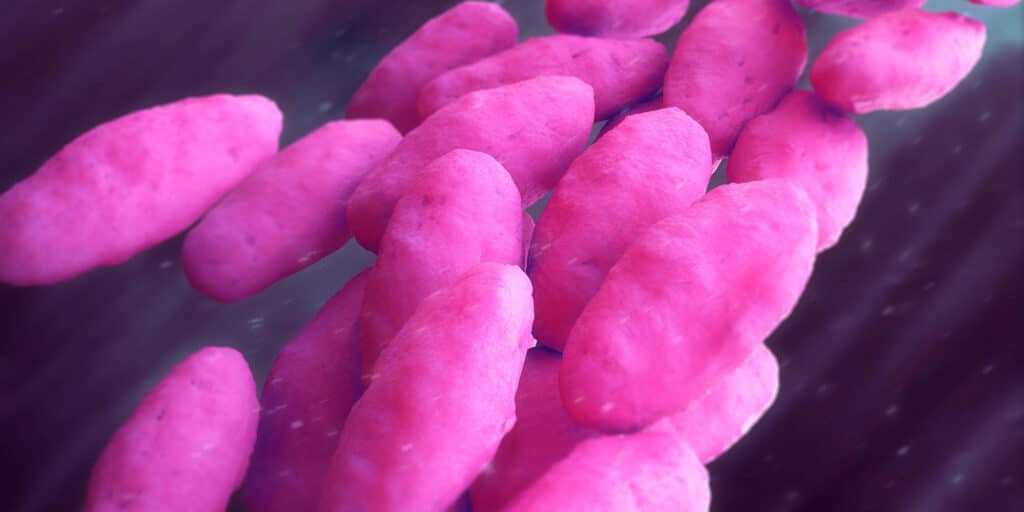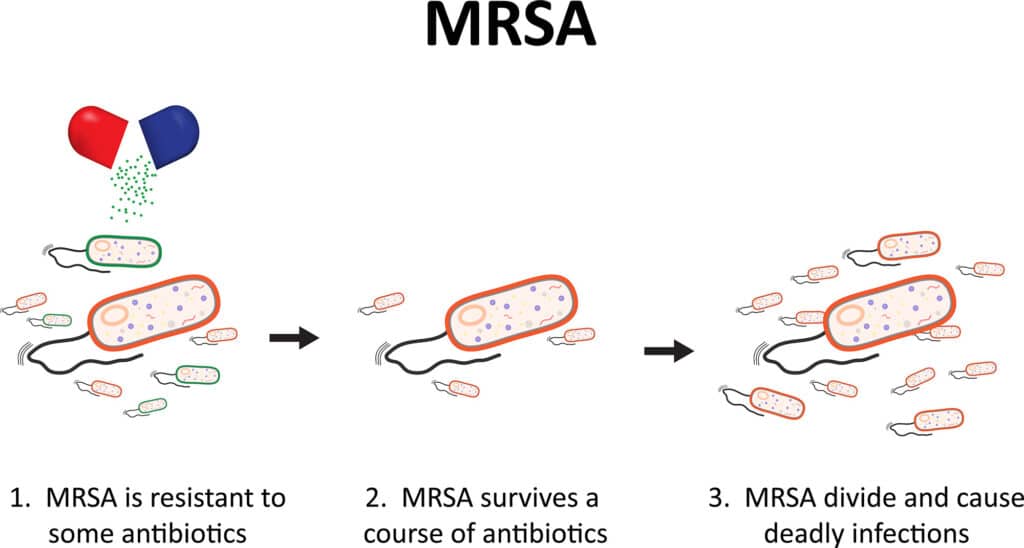Bacteria are living organisms that have only one cell. Under a microscope, these tiny organisms look like balls, rods, or spirals. They are so small that a line of 1,000 could fit in a space no larger than a pencil eraser. Most types of bacteria will not make you sick, and in the case of certain bacteria, like those found in probiotics, they can even be essential for your body’s health. However, some types of bacteria can cause infections, and as a result, can even lead to serious illness. One such bacteria is Methicillin-Resistant Staphylococcus Aureus (MRSA) which is one of the most common bacterial infections. But what is MRSA, and how can you identify it from other common bacterial infections? Below, we’ll take a closer look at the signs, symptoms, and treatments for a MRSA infection.
What Is MRSA?
Also known as staph, MRSA is an infection caused by the Staphylococcus bacteria. This type of bacteria is resistant to many different antibiotics, including penicillin, amoxicillin, oxacillin, and methicillin (as the name suggests).
The bacteria that causes MRSA typically live inside the nose and on the skin, but generally don’t cause any harm. It’s estimated that one in three people carry Staphylococcus aureus bacteria. However, if the bacteria begin to multiply uncontrollably, it can lead to a MRSA infection.
MRSA infections typically occur when there is a cut or open wound in the skin. As a result, MRSA most often causes skin infection, although it can cause pneumonia and other infections. It is extremely contagious, and can easily be spread through direct contact with someone who has the infection. It can also be contracted by touching or coming into contact with an item or object that’s been touched by someone with MRSA.
In healthy individuals, MRSA will not cause a serious infection. However, in elderly individuals, or those with weakened immune systems, MRSA can cause a serious infection. Since the bacteria that causes MRSA is already resistant to several major antibiotics, experts consider this infection to be a serious threat.
What are the Different Types of MRSA?
MRSA infections will be classified as one of two types: hospital-acquired (HA-MRSA) or community-acquired (CA-MRSA). Although MRSA can be classified as either HA or CA, the infection itself is the same despite which kind you may contract. These “different types” refer mainly to how the infection is contracted. That said, there are some distinct characteristics of each type, which we’ll take a look at below.
HA-MRSA
HA-MRSA is most commonly associated with infections that are contracted primarily in medical facilities (hence the name hospital-acquired). These facilities can be places such as hospitals, nursing homes, or other similar medical settings. You can contract HA-MRSA through direct contact with an infected wound or unwashed hands. You can also contract this infection through contact with contaminated linens or poorly sanitized medical equipment.
CA-MRSA
CA-MRSA is most often associated with infections transmitted through close personal contact with someone who has the infection, or via direct contact with an infected wound. As the name suggests, this type of MRSA occurs within the community where you live, work, shop, and go to school. This type of MRSA can also develop as a result of poor hygiene, such as poor hand washing.
Symptoms of MRSA Infection
Symptoms of a MRSA infection can vary depending on the type of infection you have, how your body’s immune system reacts to the infection, and several other factors. Below, we’ll take a closer look at the symptoms of both types of MRSA, along with when you should see a doctor.
Symptoms of HA-MRSA
As previously mentioned, HA-MRSA is most commonly contracted within medical facilities like hospitals or nursing homes. HA-MRSA is more likely to cause serious health complications like pneumonia, urinary tract infection (UTIs), and sepsis. Due to this, it is extremely important to contact your doctor immediately if you notice any of the following symptoms of HA-MRSA:
- Fever
- Cough
- Muscle aches
- Fatigue
- Chest pain
- Rash
- Headaches
- Shortness of breath
Symptoms of CA-MRSA
CA-MRSA is more common than HA-MRSA. This type of MRSA infection typically causes deep-scaled or systemic skin infections. Areas of the body with more hair, such as the back of the neck or armpits, are more likely to be infected.
The most common way CA-MRSA is spread is through contact with an open wound. Areas of the body that have been cut, scraped, or broken are highly susceptible to infection.
CA-MRSA will typically cause swollen, painful bumps to form on the skin. This bump may resemble a bug bite or blemish, and will often have a yellow or white center. Sometimes, CA-MRSA can cause the surrounding skin to become red and warm to the touch, this is known as cellulitis.
Pus and other bodily fluids may be expelled from the infected area, and some people may develop a fever.
Risk Factors for MRSA
Since the different strains of Staphylococcus bacteria occur in different settings, the risk factors for CA-MRSA and HA-MRSA differ. Below are the risk factors for both types of MRSA infections.
Risk Factors for HA-MRSA
- Being Hospitalized: MRSA is still a concern in all hospitals around the world. In the United States alone, it’s estimated that nearly 5% of all inpatients carry MRSA bacteria. Hospitals represent a large population of individuals who are at high risk for infection, especially older adults and those with weakened immune systems.
- Having an Invasive Medical Device: Medical devices that enter the body, such as tubing or other intravenous lines or catheters, can provide MRSA bacteria a pathway into your body. This typically occurs with poorly sanitized equipment.
- Residing in a Long-Term Care Facility: MRSA is a persistent threat in nursing homes. Carriers of MRSA can spread the bacteria without knowing they are sick themselves, which can make contact tracing difficult.
Risk Factors for CA-MRSA
- Participating in Contact Sports: CA-MRSA is most commonly spread via contact with an infected person, which is made easier if there are cuts and scrapes on your skin. Contact sports provide MRSA with the ideal scenario for spreading from one person to another.
- Having HIV Infection: People with HIV have a higher risk of developing MRSA infections. This is because HIV infections weaken the immune system, which makes it easier for MRSA infections to take hold.
- Living in Crowded or Unsanitary Conditions: CA-MRSA infections are fairly common in child care centers, high schools, military training camps, and jails. Areas with lots of people, especially those with poorer sanitary conditions, are more likely to be hotspots for CA-MRSA.
- Using Illicit Drugs: People who use illicit drugs that are taken intravenously are at a higher risk of MRSA infections. The opioid epidemic is thought to be connected to the rise in MRSA infections in communities. According to the Centers for Disease Control and Prevention (CDC), people who inject drugs are 16 times more likely to develop a serious staph infection.
Treatment for MRSA
Treatment for MRSA can take on several different forms depending on the type of MRSA infection you have, and how severe it is. Typically, doctors will treat HA-MRSA and CA-MRSA differently, as HA-MRSA can have potentially life-threatening effects.
Below are some common treatments for both HA-MRSA and CA-MRSA.
Treating HA-MRSA
Unlike CA-MRSA, HA-MRSA infections have the possibility of becoming life-threatening. As a result, these types of MRSA infections require intravenous antibiotics, and depending on the severity, may require long periods in the hospital.
HA-MRSA is resistant to beta-lactam antibiotics. These include penicillin and its derivatives, cephalosporins, monobactams, carbapenems, and carbacephems. This means that many of the more commonly prescribed antibiotics, like methicillin, amoxicillin, penicillin, and oxacillin, will have little to no effect on the bacteria.


In instances where HA-MRSA becomes severe, treatment may include therapies and procedures such as kidney dialysis or oxygen therapy.
Treating CA-MRSA
CA-MRSA infections will typically improve with simple oral antibiotics alone. If the infection is large enough, your doctor may recommend performing an incision to drain the wound. This procedure is generally performed in an office setting under local anesthesia. You may not need antibiotics if this procedure is performed, although your doctor may still recommend them to ensure the infection has cleared.
While treating MRSA infections can be relatively easy, preventing MRSA infections in the first place is extremely important for the health of both you and those in your community.
How to Prevent MRSA
MRSA infections, specifically CA-MRSA, are typically spread at the community level. These can be places such as schools, stores, offices, or other densely populated areas. To prevent getting or spreading MRSA, there are some simple precautions you should take:
- Wash Your Hands: Careful and regular hand washing is the best way to prevent the spread of germs, including MRSA bacteria. Scrub your hands for at least 20 seconds under warm running water, and carry hand sanitizer for times when you don’t have access to soap and water.
- Keep Wounds Covered: Keep your cuts and scrapes clean and covered with clean, dry, bandages until they are healed. MRSA is easily spread through contact with open wounds, and the pus from infected sores may contain harmful MRSA bacteria.
- Keep Personalized Items Personal: Avoid sharing personal items such as towels, toothbrushes, razors, clothing, and athletic equipment. MRSA spreads easily on infected objects.
- Shower After Athletic Games or Practices: Contact sports are an easy way for MRSA bacteria to spread. Shower immediately after each game or practice, use soap and water, and don’t share towels.
- Sanitize Linens: If you have a cut or sore, wash your towels and bed linens regularly. Use your washer’s hottest setting, and add bleach if possible. Do the same with your gym or athletic equipment after each use.
Still Wondering, “What Is MRSA?”
Ask us your questions in the comments section below!
What topics related to MRSA should we cover next?
Email us your ideas at info@painresource.com
Want even more Pain Resource content?
Join the fastest-growing chronic pain community today by clicking here!





